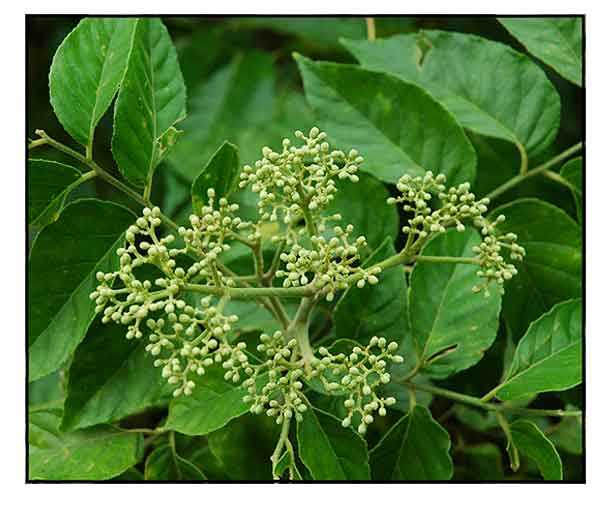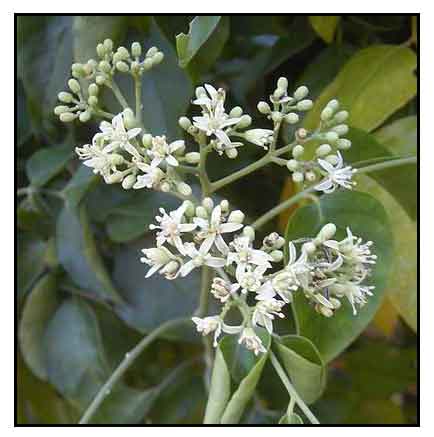 Gen info Gen info
- Micromellum is a genus of eight species of flowering plants in the family Rutaceae. The genus includes evergreen and deciduous shrubs and trees.
- The genus was first formally described in 1825 by Carl Ludwig Blume in Bijdragen tot de Flora van Nederoandsch Inidie.
Botany
Piris is a small tree with hairy branches and leaves. Leaves are 20 to 40 centimeters in length, with 9 to 12 leaflets on each side of the hairy rachis. Leaflets are variable in shape and size, ovate to broadly lanceolate, the terminal ones being longest and up to 15 centimeters in length. Flowers are fragrant, greenish yellow or white, borne in considerable numbers on compound inflorescences. Fruit is yellow when ripe, ovoid-oblong, and less than 1 centimeter in length.
Taxonomic conflict
- Quisumbing (1978) published Micromelum minutum as a synonym of Micromelum compressum. This study supports the taxonomic claim of Merrill that suggests M. compressum is not identical to M. minutum. (13)
Distribution
- Native to the Philippines and Vietnam.
-
Throughout the Philippines, in most islands and provinces, in thickets and secondary forests at low and medium altitudes.
 Constituents Constituents
- Chemical investigation of Micromelum minutum collected from Sepilok, Sabah, Malaysia yielded four new coumarins: 3",4"-dihydrocapnolactone 1, 2',3'-epoxyisocapnolactone 2, 8-hydroxyisocapnolactone-2',3'-diol 3 and 8-hydroxy-3",4"-dihydrocapnolactone-2',3'-diol 4. (2)
- Acetone extract of stems yielded six coumarins, micromarin-A ,B,C,F,G,H along with six known coumarins. (3)
- Leaves yielded coumarin, 80methoxycapnolactone and stigmasterol.
(5)
- Fractionation of crude petroleum ether and chloroform extracts isolated five new coumarins 3″,4″-dihydrocapnolactone, 2′,3′-epoxyisocapnolactone, 8-hydroxyisocapnolactone-29,39-diol, 8-hydroxy-3″,4″-dihydrocapnolactone-29,39-diol and 8,4″-dihydroxy-3″,4″-dihydrocapnolactone-29,39-diol, and two triterpenes. (See study below) (6)
- Fruits yielded new 7-oxygenated coumarin, 7-demethylmurralonginol isovalerate (1), and a new natural product, murralonginol (2), together with seven known 7-oxygenated coumarins, murralonginol isovalerate (3), murralongin (4), micromelin (5), scopoletin (6), microminutin (7), murrangatin (8), and minumicrolin (9). (See study below) (8)
- Study of fractions from air-dried powdered leaves yielded tetramethoxyflavone (1) (83.4 mg) and a mixture of pentamethoxy flavones (2 and 3) (45.6 mg). The structures were identified as 3,5,7,40-tetramethoxyflavone (1), 3,5,7,8,40-pentamethoxyflavone (2) and 3,5,6,7,40-pentamethoxyflavone (3). (11)
- Study isolated and identified three polymethoxyated flavones 1-3.
(13)
Properties
- Considered febrifuge, analgesic, stomachic, carminative.
- Studies have suggested anticancer, antitubercular properties.
Parts used
Roots, shoots, leaves.
Uses
Folkloric
- In the Philippines, young shoots are heated with oil and used for infantile convulsions.
- Leaves and roots are used as febrifuge.
- Decoction or infusion of roots used for diarrhea in children; also, as carminative.
- Roots also used for toothaches.
- Plant used for stomachache and headache.
- In Sabah and Sarawak, leaves of M. minutum are traditionally used in the treatment of giddiness and fever; poultice of boiled roots are used for ague. (6)
Others
Wood: Used for handles of bolos and making furniture.
Studies
• Cancer Prevention and Carcinogenesis Potentials: Study evaluated the effect of dietary Micromelum minutum leaves common eaten among Southern Thai people. The susceptibility of biological systems to chemical carcinogenesis is partly controlled by the balance between phase I enzyme and phase II enzymes systems, and the protective effect of vegetables and chemical compounds maybe the result of modulation of carcinogen metabolism, especially the induction of phase II detoxification enzymes. Study results show M. minutum leaves possess phase II enzyme inducing property, as well as a reducing phase I activities in rat liver. The vegetable's cancer preventing potential also carries concerns on the potential to activate chemical carcinogenesis. (4)
• Cytotoxicity / Coumarins: Crude petroleum ether and chloroform extracts of M. minutum showed strong cytotoxic activity against a T-lymphoblastic leukemia cell line. Fractionation isolated five new coumarins and two triterpenes. Some of the compounds showed strong activity against T. lymphoblastic leukemia (CEM-SS), promyelocytic leukemia (HL60), cervical cancer (HeLa) and liver cancer (HepG2) cell lines. (6)
• Cytotoxicity / Coumarins: Leaves yielded two bioactive compounds, 2',3'-Epoxyisocapnolactone and 8-hydroxyisocapnolactone-2',3'-diol. Study showed both compounds to induce apoptosis. Furthermore, 8- hydroxyisocapnolactone-2',3'-diol also exhibited earlier induction time and better cytotoxicity compared to 2',3'-epoxyisocapnolactone. Results show both to have potential as anticancer agent. (7)
• Fruits / C-7 Oxygenated Coumarins / Anti-Cancer: Fruits yielded new 7-oxygenated coumarin, 7-demethylmurralonginol isovalerate (1), and a new natural product, murralonginol (2), together with seven known 7-oxygenated coumarins, murralonginol isovalerate (3), murralongin (4), micromelin (5), scopoletin (6), microminutin (7), murrangatin (8), and minumicrolin (9). Among these isolates, compounds 2 and 4–9 exhibited cytotoxicity against cholangiocarcinoma cell line, KKU-100. (8)
• Fruits / Coumarins / Anti-Cancer: A carbon tetrachloride fraction of Micromelum minutum was found active against most test fungal test organisms. The VLC fractions showed marked inhibition against the six fungi tested; fraction D showed 62 to 88% inhibition at 500 µg/ml dose. (9)
• Mahanine / Apoptosis Induction: Mahanine, a naturally occurring carbazole alkaloid in some Asian vegetables. Study investigated the effect of mahanine on the activation of the apoptotic pathway in human leukemia U937 cells. Mahanine-induced apoptosis involved the activation of caspases, release of cytochrome c in cytosol, loss of mitochondrial membrane permeability, and decreased levels of cellular ATP. (10)
• Antitubercular: Study evaluated leaves from nine selected Philippine plants for inhibitory activity against Mycobacterium tuberculosis H37Rv. Of the nine samples, M. compressum showed the highest activity with 97% and 98% inhibition at 64 µg/mL and 128 µg/mL (MIC: 56 µg/mL) Study also reports on the isolation and characterization of secondary metabolites from ethyl acetate sub-extract inhibiting Mtb H37Rv at MIC 25 µg/mL, and the preliminary study on the anti-TB activity of stems (13% at 128 µg/mL) and bark (49% at 128 µg/mL). (12)
• Synergistic Inhibitory Effect of Polymethoxy Flavones against Mycobacterium tuberculosis H37Rv / Leaves: Study evaluated polymethoxy flavones from leaves of M. compressum with synergistic inhibitory effect against Mycobacterium tuberculosis H37Rv, Crude DCM-MeOH extract exhibited 84% inhibition against Mtb at 128 µg/mL. Partitioning yielded three fractions (McP, McD Mc
W). Partitioning of McD yielded five fractions, with the third showed 96% inhibition against Mtb, while McP showed 92% at 128 µg/mL.
Purification isolated three polymethoxy flavones mixed with McD3.3, McD3.5 and McD3.6. McD3.5 exhibited good activity with MIC of 15.98 µg/mL. Results also showed synergism of two polymethoxy flavones in enhancing inhibition of Mtb, suggesting a potential source of antitubercular constituents. (16)
Availability
Wild-crafted.
|

![]()



 Gen info
Gen info
